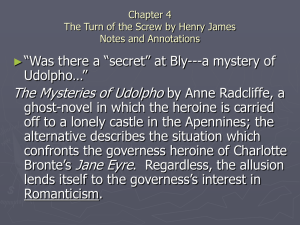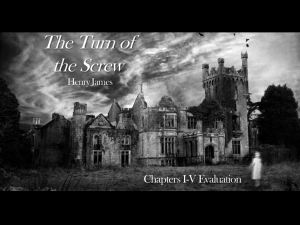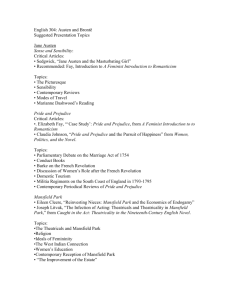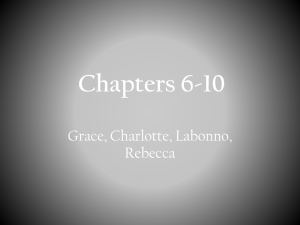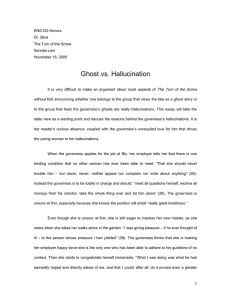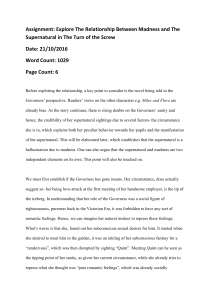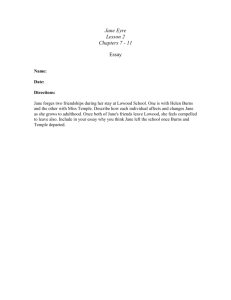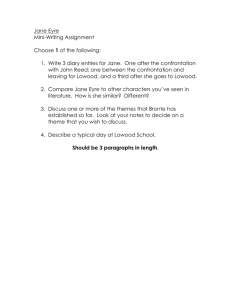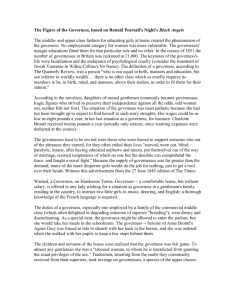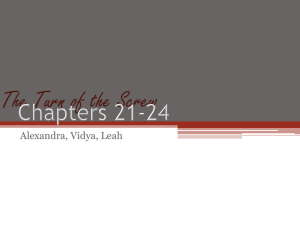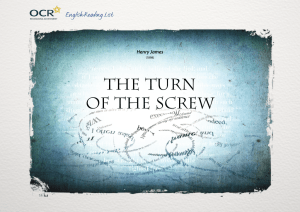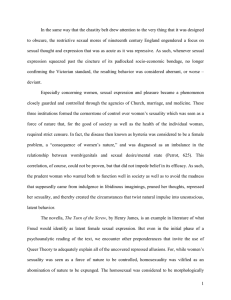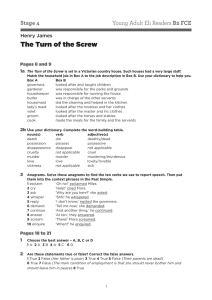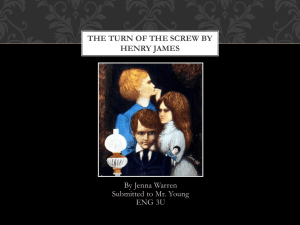from Millicent Bell, “JANE EYRE,” American Scholar, vol
advertisement
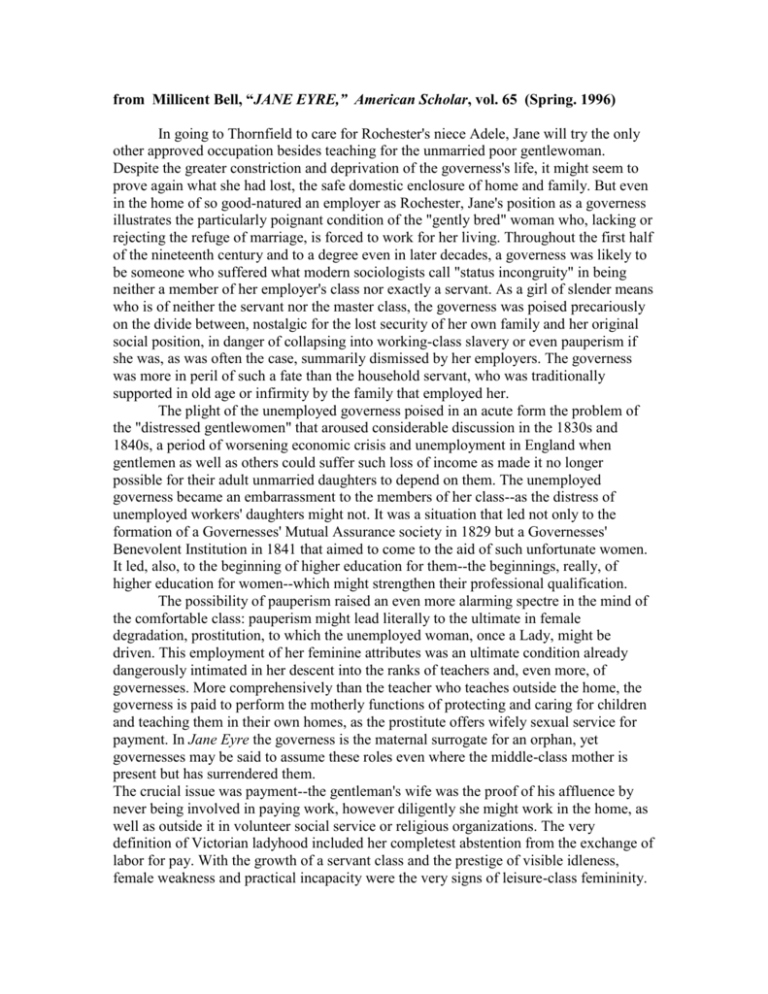
from Millicent Bell, “JANE EYRE,” American Scholar, vol. 65 (Spring. 1996) In going to Thornfield to care for Rochester's niece Adele, Jane will try the only other approved occupation besides teaching for the unmarried poor gentlewoman. Despite the greater constriction and deprivation of the governess's life, it might seem to prove again what she had lost, the safe domestic enclosure of home and family. But even in the home of so good-natured an employer as Rochester, Jane's position as a governess illustrates the particularly poignant condition of the "gently bred" woman who, lacking or rejecting the refuge of marriage, is forced to work for her living. Throughout the first half of the nineteenth century and to a degree even in later decades, a governess was likely to be someone who suffered what modern sociologists call "status incongruity" in being neither a member of her employer's class nor exactly a servant. As a girl of slender means who is of neither the servant nor the master class, the governess was poised precariously on the divide between, nostalgic for the lost security of her own family and her original social position, in danger of collapsing into working-class slavery or even pauperism if she was, as was often the case, summarily dismissed by her employers. The governess was more in peril of such a fate than the household servant, who was traditionally supported in old age or infirmity by the family that employed her. The plight of the unemployed governess poised in an acute form the problem of the "distressed gentlewomen" that aroused considerable discussion in the 1830s and 1840s, a period of worsening economic crisis and unemployment in England when gentlemen as well as others could suffer such loss of income as made it no longer possible for their adult unmarried daughters to depend on them. The unemployed governess became an embarrassment to the members of her class--as the distress of unemployed workers' daughters might not. It was a situation that led not only to the formation of a Governesses' Mutual Assurance society in 1829 but a Governesses' Benevolent Institution in 1841 that aimed to come to the aid of such unfortunate women. It led, also, to the beginning of higher education for them--the beginnings, really, of higher education for women--which might strengthen their professional qualification. The possibility of pauperism raised an even more alarming spectre in the mind of the comfortable class: pauperism might lead literally to the ultimate in female degradation, prostitution, to which the unemployed woman, once a Lady, might be driven. This employment of her feminine attributes was an ultimate condition already dangerously intimated in her descent into the ranks of teachers and, even more, of governesses. More comprehensively than the teacher who teaches outside the home, the governess is paid to perform the motherly functions of protecting and caring for children and teaching them in their own homes, as the prostitute offers wifely sexual service for payment. In Jane Eyre the governess is the maternal surrogate for an orphan, yet governesses may be said to assume these roles even where the middle-class mother is present but has surrendered them. The crucial issue was payment--the gentleman's wife was the proof of his affluence by never being involved in paying work, however diligently she might work in the home, as well as outside it in volunteer social service or religious organizations. The very definition of Victorian ladyhood included her completest abstention from the exchange of labor for pay. With the growth of a servant class and the prestige of visible idleness, female weakness and practical incapacity were the very signs of leisure-class femininity. It was certainly paradoxical, just the same, that, though her status as a paid person degraded her, the governess was entrusted with the tenderest maternal function as inculcator of morality--which was why, of course, she had to be a Lady herself, so that the values of class would have been inbred in her. In her own childhood, when her own family had been more prosperous, she had herself had a governess. But the essential of femininity, the sexual, was denied her since she had the task of conveying to the middleor upper-class child a behavioral code purged of sexual knowledge. For this reason she was, in a contemporary phrase, a "tabooed woman" for the gentlemen she came into contact with in the household in which she was employed, and also tabooed among those employed alongside of them in the same households. Nothing was more revolting than a fallen governess. There was literally nothing left for her, after her fall, than "the streets.**** Jane Eyre is a novel that daringly confronts social reality yet opposes it with the author's utopianism. Jane is a realist, yet also utopian, romantic. Her creator desires her heroine's achievement of the utopian ideal of union in which men and women, rich and poor, are no longer categories separated by iron barriers. Yet the writer's truth-admitting sense is so great that she cannot, after all, award her heroine an unqualified victory. Brontë's ending secures her heroine, grants her independence in the only way that society as well as romance sanctioned it. When she inherits an unexpected fortune from her uncle, she also immediately releases those duplications of herself, the Rivers sisters, from enslavement as governesses. And because fairy-tale cannot altogether die, she marries at last the upper-class gentleman with whom she had fallen in love. But perhaps he has become her providential destiny, too, her unforeseen duty. The subdued Rochester, broken in body and dimmed in spirit, will, with her help, regain some if not all of his former powers. But it may be that one can regard this "happy ending," along with other arbitrary improbabilities in the plot of Jane Eyre, as less important than the character of the heroine in whom the will to independence persists to the end.

